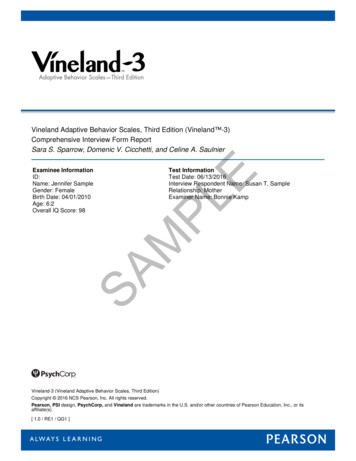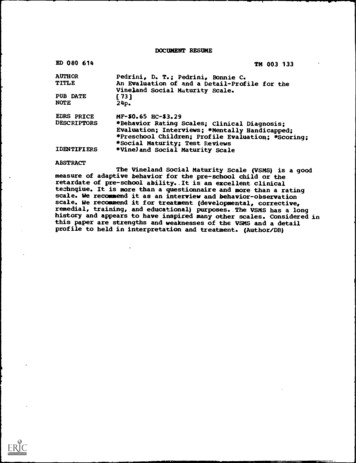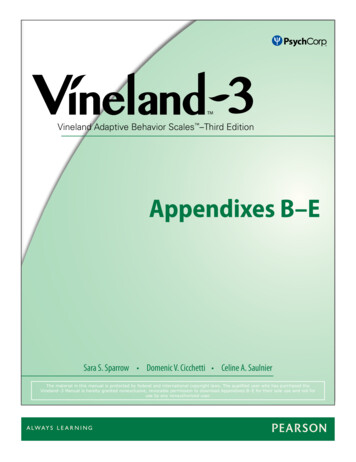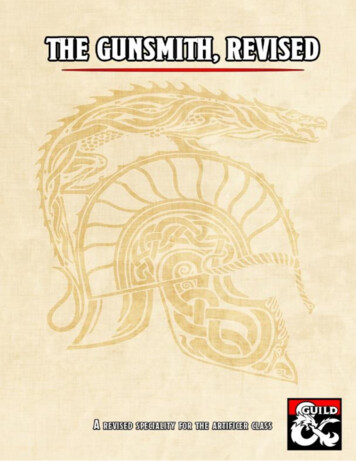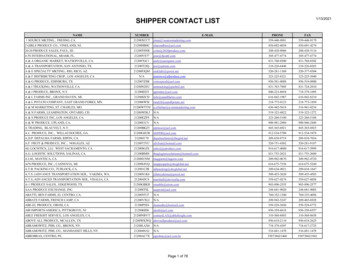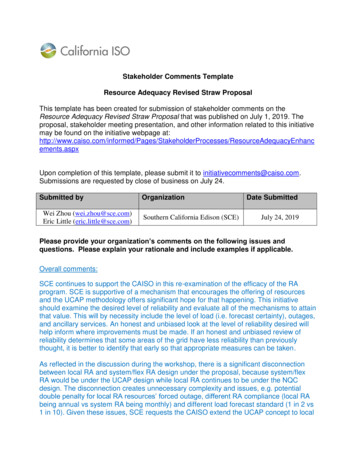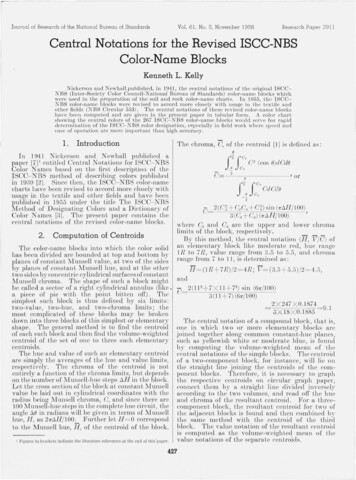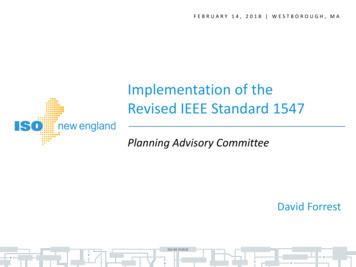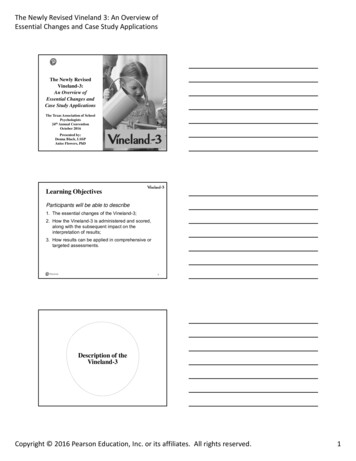
Transcription
The Newly Revised Vineland 3: An Overview ofEssential Changes and Case Study ApplicationsThe Newly RevisedVineland-3:An Overview ofEssential Changes andCase Study ApplicationsThe Texas Association of SchoolPsychologists24th Annual ConventionOctober 2016Presented by:Donna Black, LSSPAnise Flowers, PhDVineland Adaptive Behavior Scales, Third Edition 1Learning ObjectivesParticipants will be able to describe1. The essential changes of the Vineland-3;2. How the Vineland-3 is administered and scored,along with the subsequent impact on theinterpretation of results;3. How results can be applied in comprehensive ortargeted assessments.2Description of theVineland-3Copyright 2016 Pearson Education, Inc. or its affiliates. All rights reserved.1
The Newly Revised Vineland 3: An Overview ofEssential Changes and Case Study ApplicationsHistory of theVineland Social Maturity Scale Vineland Adaptive Behavior(1935 & 1965)Scales (1984; 2005; 2008; 2016)Edgar DollSara Sparrow, David Balla, DominicCichettiAdaptive behavior isdevelopmental andmultidimensional.Education for All HandicappedChildren Act of 1975 (now IDEA).Included domains Socialization,Communication, Daily Living Skills,Motor Skills.Adaptive behavior is bestassessed using a third-partyadministration.Most reliable method of obtainingaccurate information on adaptivebehavior is through a clinicalinterview with parent or caregiver.4Adaptive BehaviorDefinition: the performance of daily activitiesrequired for personal and social sufficiency.Four important principles:1. Adaptive behavior is age-related.2. Adaptive behavior is evaluated in a socialcontext.3. Adaptive behavior is modifiable.4. Adaptive behavior is defined by typicalperformance, not by ability.5Vineland-3 InstrumentsInterviewFormComprehensive3 DomainsCore AdaptiveScoresOptionalDomainsDomain-Level3 Domains9 SubdomainsParent/CaregiverFormComprehensive3 DomainsTeacherFormDomain-Level3 Domains9 SubdomainsComprehensive3 DomainsDomain-Level3 Domains9 SubdomainsOverall ABCOverall ABCOverall ABCOverall ABCOverall ABCOverall ABCMotor SkillsMotor SkillsMotor SkillsMotor SkillsMotor SkillsMotor rMaladaptiveBehaviorAge RangeBirth to 90 3 to 90 Birth to 90 3 to 90 3 to 213 to 21Item Count502195502180333149Vineland Adaptive Behavior Scales, Third Edition 6Copyright 2016 Pearson Education, Inc. or its affiliates. All rights reserved.2
The Newly Revised Vineland 3: An Overview ofEssential Changes and Case Study ApplicationsUpdatesVineland-3 UpdatesRemovedthe words“Rating,”“Survey,” &“Expanded.”Three FormsInterview Parent/Caregiver TeacherEach form has Comprehensive and Domain LevelMotor Skills &MaladaptiveBehavior areoptional.DomainsCommunication Daily Living Skills Socialization Motor Skills ittenPersonalDomestic/NumericComm/SchoolInterpers. RelationsPlay & LeisureCoping SkillsGross MotorFine MotorGross/FineMotor areoptional.Removed“Other”section.Maladaptive SectionsInternalizing Externalizing CriticalVineland Adaptive Behavior Scales, Third Edition 8Vineland-3 Updates (continued)NewOnlineAdministration!Later Start Ages1. Basal and ceilingrules2. Suggestedinterview questionsand item-specificprobesItem Scoring ChangesParent/CaregiverForms in SpanishVineland Adaptive Behavior Scales, Third Edition 9Copyright 2016 Pearson Education, Inc. or its affiliates. All rights reserved.3
The Newly Revised Vineland 3: An Overview ofEssential Changes and Case Study ApplicationsUpdated Item Content Items were updated to current standards Outdated items were dropped or modified Communication domain items were modified to allowfor alternative/augmentative forms of communication(e.g., sign language; voice output devices) Items are more culturally sensitive with wording toallow for cultural differences (e.g., utensils vs.chopsticks) Efforts to reduce redundancy and streamline similaritems to specific subdomains (e.g., moving allconversational items to Socialization)10Updates/Additions in Item Content Expanded Receptive subdomain includes moreitems at all developmental levels– e.g., more items about gesture use and nonverbalcommunication Expanded Written subdomain includes moreitems at all developmental levels– e.g., more items about pre-reading & writing skills, aswell as more advanced skills Addition of items in the Personal subdomainreflects healthy eating habits and exercisechoices– e.g., not only showing awareness that some foods arehealthier than others, but also taking the initiative tomake healthy eating choicescontinued Vineland Adaptive Behavior Scales, Third Edition 11Updates/Additions in Item Content Updated Community subdomain reflects use oftechnology for everyday purposes– e.g., using the internet to obtain information Addition of items in the Coping subdomainassesses for social gullibility– e.g., “understands that a friendly appearing person mayactually intend harm”; “recognizes that advertisingmessages may not be accurate”Vineland Adaptive Behavior Scales, Third Edition 12Copyright 2016 Pearson Education, Inc. or its affiliates. All rights reserved.4
The Newly Revised Vineland 3: An Overview ofEssential Changes and Case Study ApplicationsOnline Administration Options for online completion of all 3 forms Q-global will automatically keep track of basal, ceiling, andsubdomain completion rulesINTERVIEW FORM: Q-global conveniently organizes items with related content bytopic Interview Topics include 2 to 6 items All information for the items within an Interview Topic isdisplayed on a single screenVineland Adaptive Behavior Scales, Third Edition 13Interview Topic Screen TOPIC AREA: The topic area name is at the top of the screen– e.g., “Friendships” SUGGESTED INTERVIEW QUESTION: Listed beneath theTopic Area– e.g., “Tell me about Stella’s Friendships” ITEM-SPECIFIC PROBE: Click to see a more detailedquestion– e.g., “How does Stella Try to make friends with others her age?” SCORING CRITERIA: Click to see scoring criteria– e.g., “Examples include asking for a play date or to gosomewhere with another child”SUGGESTED INTERVIEW QUESTIONS AND PROBES ARE AVAILABLEIN THE VINELAND-3 BOOKLET AND MANUAL14Sample Interview Topic ScreenTOPICAREAItem-SpecificProbeAdditional ScoringCriteria if Needed15Copyright 2016 Pearson Education, Inc. or its affiliates. All rights reserved.5
The Newly Revised Vineland 3: An Overview ofEssential Changes and Case Study ApplicationsChanges to Basal & Ceiling RulesComprehensive FormsBasal/CeilingFormVINELAND-IIVINELAND-3Basal4 consecutive scores of 24 consecutive scores of 2Ceiling4 consecutive scores of 04 consecutive scores of 0Parent completed entire form5 consecutive scores of 2InterviewBasalParent/CaregiverCeilingParent completed entire form5 consecutive scores of 0BasalTeacher completed age range5 consecutive scores of 2CeilingTeacher completed age range5 consecutive scores of 0TeacherVineland Adaptive Behavior Scales, Third Edition 16Vineland-3 Report UpdatesItem-Level ComparisonIntervention GuidanceVineland Adaptive Behavior Scales, Third Edition 17Modifications to Scoring ResponsesRESPONSE OPTIONVINELAND-IIVINELAND-32UsuallyUsually (Int.)Usually or Often (P/C & T)1Sometimes or PartiallySometimes0NeverNeverMaladaptive Domain2UsuallyOften18Copyright 2016 Pearson Education, Inc. or its affiliates. All rights reserved.6
The Newly Revised Vineland 3: An Overview ofEssential Changes and Case Study ApplicationsRationale for Modifying theWording of a Score of “1” In the Vineland-II, a score of 1 could be obtainedif an individual performed the behavior sometimeswith independence, or performed only part of thebehavior with independence This scoring method gave credit for partialindependence The Vineland-3 considers a behavior fullyindependent only if the entire behavior isperformed19Introduction of Estimated Items Elimination of “Don’t Know” and “No Opportunity”item response options from Vineland-II Introduction of Estimated Item response optionsfor every item across all 3 forms Rationale is that a very familiar respondent’s“educated guess” will be more accurate than anassignment of DK or N/O, which were givenpartial credit (i.e., a score of 1) in Vineland-II20Ages for eAllExpressiveAllWritten3 and OlderDaily Living SkillsSocializationMotor SkillsPersonalAllDomestic/Numeric*3 and OlderCommunity/School*3 and OlderInterpersonal RelationsAllPlay and LeisureAllCoping Skills2 and OlderGross MotorBirth through 9Fine MotorMaladaptiveBehaviorsAges AdministeredBirth through 93 through Adult* Different Subdomain used in the Teacher Form21Copyright 2016 Pearson Education, Inc. or its affiliates. All rights reserved.7
The Newly Revised Vineland 3: An Overview ofEssential Changes and Case Study ApplicationsStructure of theVineland-3Vineland-3 Domains & ressiveWrittenDaily Living SkillsPersonalDomestic/Numeric*Community/School Community*SocializationInterpersonal RelationshipsPlay and LeisureCoping SkillsMotor Skills (optional)Gross MotorFine MotorMaladaptive Behaviors(optional)Internalizing, Externalizing, & CriticalItems (Sections)* A different subdomain is used in the Teacher Form23Definitions of Vineland-3Adaptive Behavior SubdomainsDomain and , Understanding, andresponding appropriately toinformation from othersExpressiveUsing words and sentences toexpress oneself verbally to othersWrittenUsing reading and writing skills24Copyright 2016 Pearson Education, Inc. or its affiliates. All rights reserved.8
The Newly Revised Vineland 3: An Overview ofEssential Changes and Case Study ApplicationsDefinitions of Vineland-3Adaptive Behavior SubdomainsDomain and SubdomainDefinitionDaily Living Skills DomainPersonalSelf-sufficiency in such areas as eating,dressing, washing, hygiene, and health careDomestic (a)Performing household tasks such ascleaning up after oneself, chores, and foodpreparationNumeric (b)Using numeric concepts in practical ways,including time, dates, and moneyCommunity (a)Functioning in the world outside the home,including safety, using money, travel, rightsand responsibilities, etc.School Community(b)Meeting expectations for appropriatebehavior within the school environmenta – Interview & Parent/Caregiver Forms onlyb – Teacher Form only25Definitions of Vineland-3Adaptive Behavior SubdomainsDomain and SubdomainDefinitionSocialization DomainInterpersonal RelationshipsResponding and relating to others,including friendships, caring, socialappropriateness, and conversationPlay and LeisureEngaging in play and fun activities withothersCoping SkillsDemonstrating behavior and emotionalcontrol in different situations involvingothers26Definitions of Vineland-3Adaptive Behavior SubdomainsDomain and SubdomainDefinitionMotor Skills Domain (Optional & no longer included in ABC)Gross MotorFine MotorPhysical skills in using arms and legs formovement and coordination in daily lifePhysical skills in using hands and fingers tomanipulate objects in daily lifeMaladaptive Behavior Domain (Optional)InternalizingProblem behaviors of an emotional natureExternalizingProblem behaviors of an acting-out natureCritical ItemsMore severe maladaptive behaviors; do notform a unified construct, and therefore arenot scored as a scale27Copyright 2016 Pearson Education, Inc. or its affiliates. All rights reserved.9
The Newly Revised Vineland 3: An Overview ofEssential Changes and Case Study ApplicationsMotor Skills Domain On Vineland-II, Motor Skills Domain was required forcomputing the ABC score for ages birth to 6 On Vineland-3, Motor Skills Domain no longer required tocompute the ABC score Primary reason for removal of the Motor Skills Domainfrom the ABC score:– To align with criteria currently specified by AAIDD indiagnosis of intellectual disability (i.e., two standarddeviations below the mean on conceptual, social, orpractical; or two standard deviations below mean onone standardized measure of conceptual, social, andpractical skills)28Maladaptive Behavior Domain Provides a brief assessment of problem behaviors Aids in diagnosis or intervention planning for examineesages 3 and older Divided into three sections: Internalizing, Externalizing,and Critical Items– Internalizing and Externalizing sections have a v-scalescore with normative mean of 15 and standard deviationof 3– Critical items cover a wide range of severe problembehaviors, including disordered thinking, restrictive andrepetitive behaviors and interests, self-harm, and extremeviolence and cruelty29Completion Times in MinutesExamineeAgeCoreDomainsMotor Skills(O)Maladaptive Behavior(O)Comprehensive Interview Form0-220-254-5N/A3-935-402-33-410-90 25-30N/A3-42-3*2-3Domain-Level Interview Form3-90 23-27Comprehensive Parent/Caregiver main-Level Parent/Caregiver Form3-90 omprehensive Teacher FormDomain-Level Teacher Form3-218-1030*Ages 3-9 onlyCopyright 2016 Pearson Education, Inc. or its affiliates. All rights reserved.10
The Newly Revised Vineland 3: An Overview ofEssential Changes and Case Study ApplicationsUses of the Vineland-3Uses of the Vineland-3 Diagnosing Developmental Delay, IntellectualDisability, and Autism Spectrum Disorder (ASD) Eligibility determination Intervention Planning Progress Monitoring32MaterialsCopyright 2016 Pearson Education, Inc. or its affiliates. All rights reserved.11
The Newly Revised Vineland 3: An Overview ofEssential Changes and Case Study ApplicationsVineland-3 MaterialsInterview form:ComprehensiveDomain-LevelParent/Caregiver Form:ComprehensiveDomain-LevelTeacher Form:ComprehensiveDomain-Level34Record Forms35Vineland-3FormsCopyright 2016 Pearson Education, Inc. or it
Vineland-3 Instruments Vineland Adaptive Behavior Scales, Third Edition Interview Form Parent/Caregiver Form Teacher Form Comprehensive Domain-Level Comprehensive Domain-Level Comprehensive Domain-Level Core Adaptive Scores 3 Domains 9 Subdomains Overall ABC 3 Domains Overall ABC 3 Domains 9 Subdomains Overall ABC 3 Domains Overall ABC 3 .
